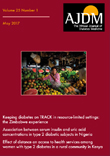Understanding the complications of juvenile diabetes
*Corresponding Author:
Received: 01-Nov-2022, Manuscript No. ajdm-22-81292 ; Editor assigned: 03-Nov-2022, Pre QC No. ajdm-22-81292 (PQ); Reviewed: 17-Nov-2022, QC No. ajdm-22-81292 ; Revised: 22-Nov-2022, Manuscript No. ajdm-22-81292 (R); Published: 29-Nov-2022
Description
Diabetes, often known as an autoimmune disease, consists of two main types. Type 1 diabetes primarily affects children also called juvenile diabetes. Young children often suffer from type 1 diabetes, in which the pancreas cannot produce enough insulin in the body. This type of diabetes can be diagnosed when the child is between the ages of 10 and 13. Most Signs and symptoms in toddlers and toddlers may not be easy to spot, but if you notice symptoms in your toddler, you should see a pediatrician right away. Remember that it may be irreversible. However, it’s important to remember that your child can maintain a normal life if the condition can be managed effectively through simple lifestyle changes. The child looks very tired. In healthy infants, the food we eat is broken down into sugars that are absorbed by the body and used as energy. This is not the case in infants with childhood diabetes.
Glucose is not converted into energy, leading to fatigue. Another important sign of diabetes that should not be overlooked in early childhood is yeast infection. This can be confusing at first. However, if your child is known to have frequent rashes when diapers are removed, it is possible that your child has diabetes. A baby’s breath and urine have a distinct fruity smell as the infant’s body tries to get rid of all the unwanted glucose that has built up in the body due to diabetes. You need to be aware of this and not ignore different smelling breath or urine at all costs.
Diabetes is unable to convert glucose into energy. As a result, the body’s cells and muscles get tired and want more food all the time. The organs want this energy to function properly, and a lack of it can cause extreme hunger in young children. Diabetes Infant weight loss is sudden and fairly rapid. The body cannot convert glucose into much-needed energy, and the child suddenly loses weight even though he is very hungry all the time increase. When blood sugar levels rise, the body tries to get rid of them by excretion. Infants may not always be able to quench their thirst, as the necessary fluids are also eliminated from the body throughout the process to produce urine. The problem of frequent urination becomes more severe, especially at night. Of course, drinking more water and other fluids increases your need to urinate more. Another important sign that can help you guess that your child has something called diabetes is that their vision may be blurred. Then all essential fluids are also removed from other body tissues. Thus the eyes are also affected, leading to blindness in children. If your child goes undiagnosed with diabetes for a long time, they may suffer from a condition known as diabetic ketoacidosis. When your child’s body doesn’t have enough insulin to convert the glucose from food into energy, it begins breaking down fat to make energy. Ketone bodies are stored in the body. These ketones are acidic in nature and alter the pH of the blood.
This condition is called diabetic ketoacidosis and is extremely fatal. If the onset of diabetes can be diagnosed early, the disease can be treated and the child can lead a healthy and normal life. Otherwise, the situation becomes too complicated and difficult to deal with effectively.
Acknowledgment
None
Conflict of Interest
The author has nothing to disclose and also state no conflict of interest in the submission of this manuscript.





